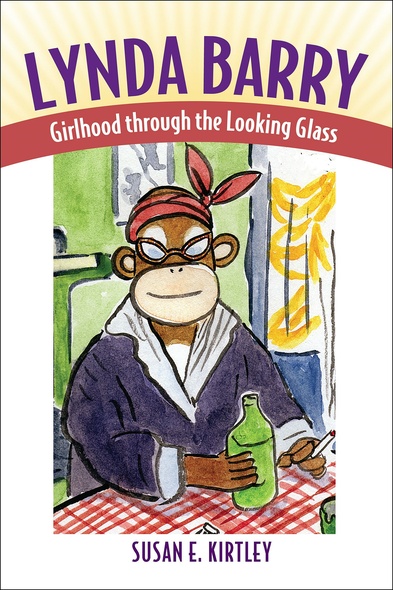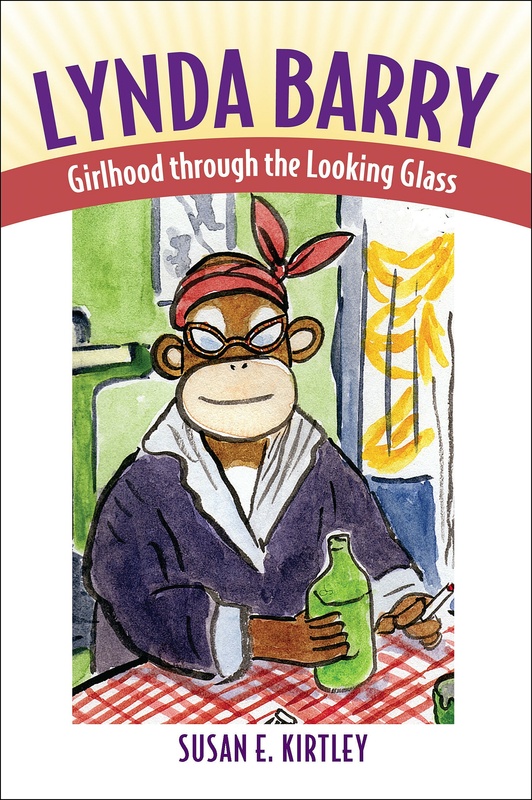
Lynda Barry
Girlhood through the Looking Glass
Best known for her long-running comic strip Ernie Pook’s Comeek, illustrated fiction (Cruddy, The Good Times Are Killing Me), and graphic novels (One! Hundred! Demons!), the art of Lynda Barry (b. 1956) has branched out to incorporate plays, paintings, radio commentary, and lectures. With a combination of simple, raw drawings and mature, eloquent text, Barry’s oeuvre blurs the boundaries between fiction and memoir, comics and literary fiction, and fantasy and reality. Her recent volumes What It Is (2008) and Picture This (2010) fuse autobiography, teaching guide, sketchbook, and cartooning into coherent visions.
In Lynda Barry: Girlhood through the Looking Glass, author Susan E. Kirtley examines the artist’s career and contributions to the field of comic art and beyond. The study specifically concentrates on Barry’s recurring focus on figures of young girls, in a variety of mediums and genres. Barry follows the image of the girl through several lenses—from text-based novels to the hybrid blending of text and image in comic art, to art shows and coloring books. In tracing Barry’s aesthetic and intellectual development, Kirtley reveals Barry’s work to be groundbreaking in its understanding of femininity and feminism.
I thought I knew about Lynda Barry, until I read Susan Kirtley’s Lynda Barry: Girlhood through the Looking Glass. In each chapter, Kirtley gives us new, provocative interpretations of such diverse Barry texts as the Naked Ladies! Naked Ladies! Naked Ladies! coloring book, The Good Times Are Killing Me play, the novel Cruddy and the graphic novel What It Is. Kirtley’s writing—a combination of enviable clarity and the savvy application of narratology, comic art theory, and other ideas—does justice to Barry’s kaleidoscopic take on troubled American girlhood. Anyone interested in Barry, female comics creators, or contemporary comics culture should read Kirtley’s book.
Kirtley brings just the right combination of wit, wisdom and creative quirkiness to this important first academic study of the witty, wise and mercurial Lynda Barry. Focusing on Barry’s lifelong engagement with the inner lives of girls across various graphic forms—comic strips, illustrated novels, graphic memoirs, and autobiographical workshop texts—Kirtley brilliantly avoids the trap of trying to pin Barry down within either comics or American literary history, instead allowing Barry’s career as an ‘image-wrangler' to define its own rules and ultimately its own canon.
No one renders girlhood or reanimates memory like Lynda Barry. Susan Kirtley’s new book makes a thoroughly powerful argument for devoting critical attention to Barry’s work, indeed for placing Barry close to the center of our consideration of autobiography, the literature of adolescence, and the graphic novel. As Kirtley so ably demonstrates, there are many sides to Lynda Barry’s career, and Lynda Barry: Girlhood through the Looking Glass is the first place where they have been assembled with the critical synthesis they deserve.
Susan E. Kirtley is professor of English, director of composition, and director of comics studies at Portland State University. She is winner of the 2013 Eisner Award for Best Educational/Academic Work for her book Lynda Barry: Girlhood through the Looking Glass and coeditor (with Antero Garcia and Peter E. Carlson) of With Great Power Comes Great Pedagogy: Teaching, Learning, and Comics, both published by University Press of Mississippi.




